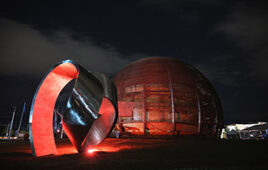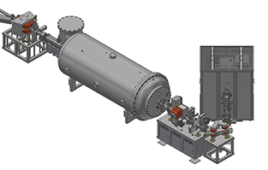As scientists and policymakers around the world try to combat the increasing rate of climate change, they have focused on the chief culprit: carbon dioxide.
Produced by the burning of fossil fuels in power plants and car engines, carbon dioxide continues to accumulate in the atmosphere, warming the planet. But trees and other plants do slowly capture carbon dioxide from the atmosphere, converting it to sugars that store energy.
In a new study from the U.S. Department of Energy’s Argonne National Laboratory and the University of Illinois at Chicago, researchers have found a similar way to convert carbon dioxide into a usable energy source using sunlight.
One of the chief challenges of sequestering carbon dioxide is that it is relatively chemically unreactive. “On its own, it is quite difficult to convert carbon dioxide into something else,” says Argonne chemist Larry Curtiss, an author of the study.
To make carbon dioxide into something that could be a usable fuel, Curtiss and his colleagues needed to find a catalyst — a particular compound that could make carbon dioxide react more readily. When converting carbon dioxide from the atmosphere into a sugar, plants use an organic catalyst called an enzyme; the researchers used a metal compound called tungsten diselenide, which they fashioned into nanosized flakes to maximize the surface area and to expose its reactive edges.
While plants use their catalysts to make sugar, the Argonne researchers used theirs to convert carbon dioxide to carbon monoxide. Although carbon monoxide is also a greenhouse gas, it is much more reactive than carbon dioxide and scientists already have ways of converting carbon monoxide into usable fuel, such as methanol. “Making fuel from carbon monoxide means travelling ‘downhill’ energetically, while trying to create it directly from carbon dioxide means needing to go ‘uphill,'” says Argonne physicist Peter Zapol, another author of the study.
Although the reaction to transform carbon dioxide into carbon monoxide is different from anything found in nature, it requires the same basic inputs as photosynthesis. “In photosynthesis, trees need energy from light, water and carbon dioxide in order to make their fuel; in our experiment, the ingredients are the same, but the product is different,” says Curtiss.
The setup for the reaction is sufficiently similar to nature that the research team was able to construct an “artificial leaf” that could complete the entire three-step reaction pathway. In the first step, incoming photons — packets of light — are converted to pairs of negatively-charged electrons and corresponding positively charged “holes” that then separate from each other. In the second step, the holes react with water molecules, creating protons and oxygen molecules. Finally, the protons, electrons and carbon dioxide all react together to create carbon monoxide and water.
“We burn so many different kinds of hydrocarbons — like coal, oil or gasoline — that finding an economical way to make chemical fuels more reusable with the help of sunlight might have a big impact,” Zapol says.
Towards this goal, the study also showed that the reaction occurs with minimal lost energy — the reaction is very efficient. “The less efficient a reaction is, the higher the energy cost to recycle carbon dioxide, so having an efficient reaction is crucial,” Zapol says.
According to Curtiss, the tungsten diselenide catalyst is also quite durable, lasting for more than 100 hours — a high bar for catalysts to meet.
The study, “Nanostructured transition metal dichalcogenide electrocatalysts for CO2 reduction in ionic liquid,” is published in Science. Much of the experimental work was performed at the University of Illinois at Chicago, while the computational work was performed at Argonne.
The research was funded by the U.S. Department of Energy’s Office of Science and the National Science Foundation.
Source: Argonne National Laboratory




